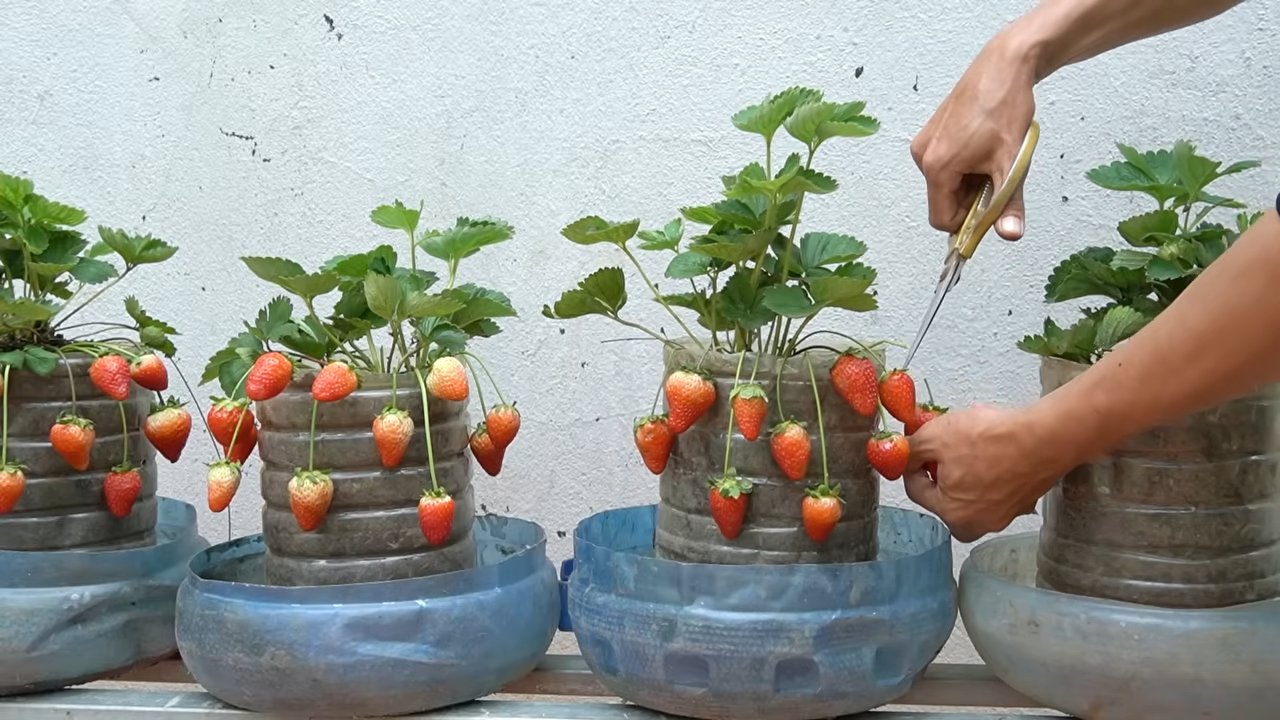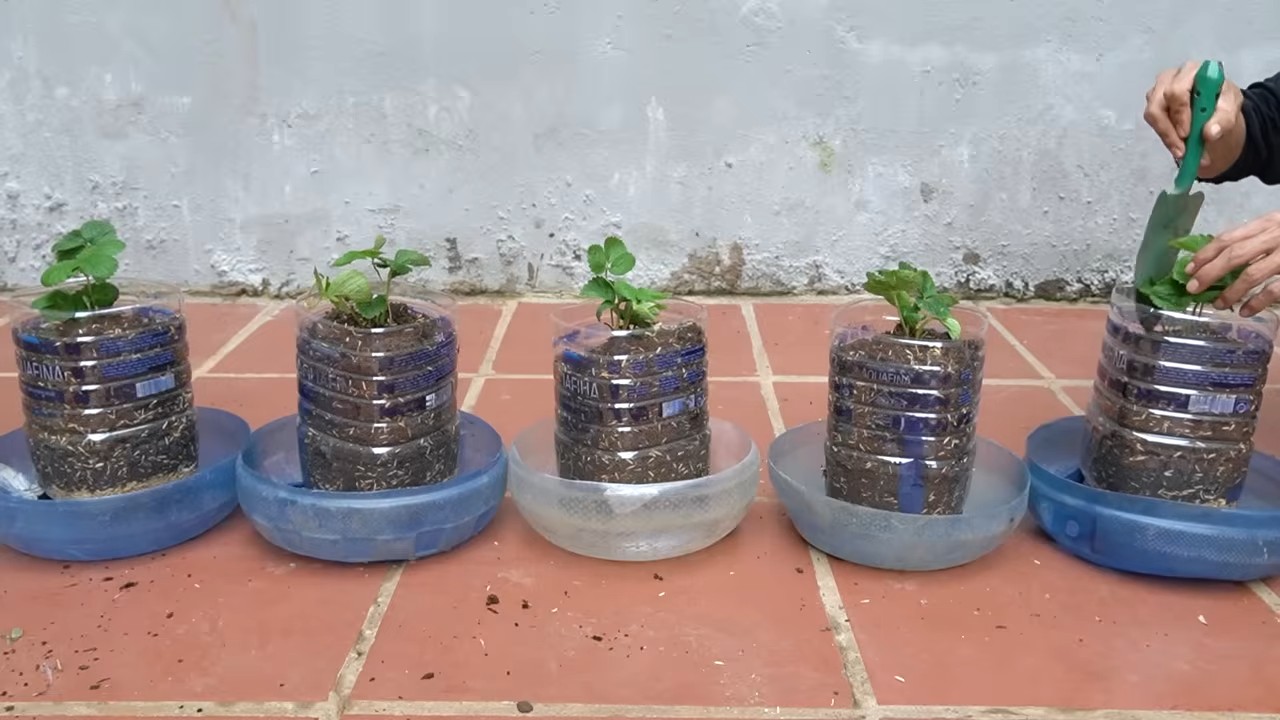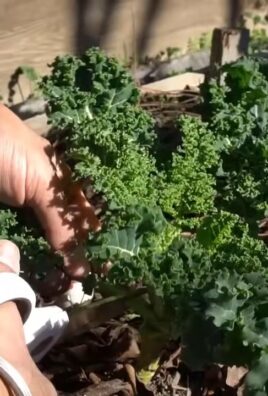Strawberry Growing Tips: Who doesn’t love the taste of a sun-ripened, juicy strawberry, bursting with flavor? Imagine plucking those ruby-red gems straight from your own backyard! For centuries, strawberries have been cherished, not just for their deliciousness, but also for their vibrant color and the joy they bring. From ancient Roman gardens to modern-day desserts, strawberries have always held a special place in our hearts (and stomachs!).
But let’s be honest, sometimes growing these little beauties can feel like a challenge. Pests, diseases, and unpredictable weather can all conspire to keep you from enjoying a bountiful harvest. That’s where these DIY tricks and hacks come in! I’m going to share some simple, yet effective, strawberry growing tips that will help you maximize your yield and minimize your frustrations.
Whether you’re a seasoned gardener or just starting out, these tips will empower you to create a thriving strawberry patch, even in a small space. Think of it: fresh strawberries for breakfast, homemade jam, and the satisfaction of knowing you grew them yourself. Ready to unlock the secrets to a successful strawberry harvest? Let’s get started!

DIY Strawberry Paradise: From Tiny Seeds to Berry Bonanza!
Hey there, fellow garden enthusiasts! I’m so excited to share my tried-and-true methods for growing the juiciest, most delicious strawberries you’ve ever tasted. Forget those bland, store-bought berries – we’re talking about homegrown goodness bursting with flavor! This guide is packed with tips and tricks I’ve learned over the years, so get ready to transform your garden (or even your balcony!) into a strawberry paradise.
Choosing the Right Strawberry Variety
Before we even think about planting, let’s talk about strawberry varieties. This is crucial because different types thrive in different climates and produce fruit at different times.
* June-Bearing Strawberries: These are your classic, one-big-harvest-per-year kind of strawberries. They produce a large crop, usually in late spring or early summer (hence the name!). If you want a lot of berries all at once for jam-making or freezing, these are a great choice.
* Everbearing Strawberries: Don’t let the name fool you – they don’t produce berries *constantly*. Instead, they have two or three distinct harvests throughout the spring, summer, and fall. They’re perfect if you want a steady supply of strawberries over a longer period.
* Day-Neutral Strawberries: These are the most consistent producers, fruiting throughout the growing season as long as the temperature is between 35°F and 85°F. They’re less sensitive to day length than the other two types.
My Recommendation: I personally love growing a mix of everbearing and day-neutral varieties. This way, I get a continuous supply of strawberries from spring until frost! Do some research on what grows best in your specific region. Your local nursery is a great resource!
Preparing Your Strawberry Patch
Strawberries need a sunny spot and well-drained soil. Here’s how to get your garden ready:
* Sunlight: Strawberries need at least 6-8 hours of direct sunlight per day. The more sun, the more berries!
* Soil: Strawberries prefer slightly acidic soil with a pH between 5.5 and 6.8. Amend your soil with compost or peat moss to improve drainage and add nutrients.
* Weed Control: Strawberries don’t like competition. Remove all weeds from the planting area before you start. I like to use a combination of hand-weeding and a layer of organic mulch.
* Raised Beds (Optional): If you have heavy clay soil or poor drainage, consider planting your strawberries in raised beds. This will help improve drainage and prevent root rot.
Planting Your Strawberry Plants
Now for the fun part – planting! Whether you’re starting with bare-root plants or potted plants, the process is pretty similar.
1. Soak Bare-Root Plants: If you’re using bare-root plants, soak the roots in water for about an hour before planting. This will help rehydrate them.
2. Dig the Holes: Dig holes that are large enough to accommodate the roots of your strawberry plants. Space the plants about 12-18 inches apart in rows that are 2-3 feet apart.
3. Planting Depth: This is crucial! Make sure the crown of the plant (where the roots meet the stem) is level with the soil surface. Planting too deep can cause the crown to rot, while planting too shallow can dry out the roots.
4. Spread the Roots: Gently spread the roots out in the hole before backfilling with soil.
5. Water Thoroughly: After planting, water the plants thoroughly to settle the soil and help them establish.
Caring for Your Strawberry Plants
Once your strawberry plants are in the ground, they need regular care to thrive.
* Watering: Strawberries need consistent moisture, especially during fruiting. Water deeply whenever the top inch of soil feels dry. Avoid overhead watering, which can promote fungal diseases. Drip irrigation or soaker hoses are ideal.
* Fertilizing: Fertilize your strawberry plants in early spring with a balanced fertilizer. Avoid over-fertilizing, which can lead to excessive foliage growth at the expense of fruit production. I like to use an organic fertilizer specifically formulated for berries.
* Mulching: Apply a layer of organic mulch around your strawberry plants to help retain moisture, suppress weeds, and keep the berries clean. Straw is a classic choice, but you can also use wood chips, pine needles, or shredded leaves.
* Pest and Disease Control: Keep an eye out for common strawberry pests like slugs, snails, and aphids. Hand-picking, beer traps (for slugs and snails), and insecticidal soap can help control these pests. Prevent fungal diseases by providing good air circulation and avoiding overhead watering.
* Renovating June-Bearing Strawberries: After your June-bearing strawberries have finished fruiting, it’s important to renovate the patch. This involves mowing the foliage down to about an inch above the crown and thinning out the plants. This will help promote new growth and improve fruit production in the following year.
Dealing with Runners
Strawberry plants produce runners, which are long stems that grow horizontally and develop new plantlets at the nodes.
* June-Bearing Strawberries: For June-bearing strawberries, you’ll want to remove the runners to encourage the plants to focus their energy on fruit production.
* Everbearing and Day-Neutral Strawberries: For everbearing and day-neutral strawberries, you can either remove the runners or allow them to root and form new plants. If you want to expand your strawberry patch, let the runners root. If you want larger berries, remove the runners.
My Tip: I usually let a few runners root each year to replace older plants. This helps keep my strawberry patch healthy and productive.
Harvesting Your Strawberries
The moment you’ve been waiting for! Harvesting your own strawberries is incredibly rewarding.
* Ripeness: Strawberries are ready to harvest when they are fully red and slightly soft to the touch.
* Harvesting Technique: Gently twist or cut the stem of the strawberry just above the cap. Avoid pulling the berries, which can damage the plant.
* Timing: Harvest your strawberries in the morning, after the dew has dried. This is when they are at their peak flavor.
* Storage: Store your freshly harvested strawberries in the refrigerator. They are best eaten within a few days.
Protecting Your Strawberries from Birds
Birds love strawberries just as much as we do! Here are a few ways to protect your precious berries:
* Netting: Cover your strawberry plants with bird netting. Make sure the netting is securely anchored to the ground to prevent birds from getting underneath.
* Scarecrows: A traditional scarecrow can help deter birds.
* Shiny Objects: Hang shiny objects like aluminum pie plates or CDs near your strawberry plants. The reflections can scare birds away.
* Decoy Berries: Place a few fake strawberries around your plants. Birds may peck at the fake berries and leave the real ones alone.
Growing Strawberries in Containers
Don’t have a garden? No problem! You can grow strawberries in containers.
* Container Size: Choose a container that is at least 12 inches in diameter and 8 inches deep.
* Potting Mix: Use a high-quality potting mix that drains well.
* Planting: Plant your strawberry plants in the container, spacing them about 6-8 inches apart.
* Watering and Fertilizing: Water and fertilize your container-grown strawberries regularly. They will dry out more quickly than plants in the ground.
* Sunlight: Place your container in a sunny location that receives at least 6-8 hours of direct sunlight per day.
Overwintering Your Strawberry Plants
In colder climates, you’ll need to protect your strawberry plants from the winter weather.
* Mulching: Apply a thick layer of mulch around your strawberry plants in late fall. This will help insulate the roots and protect them from freezing temperatures.
* Covering: In very cold climates, you may need to cover your strawberry plants with a row cover or tarp.
* Container-Grown Plants: Move container-grown strawberry plants to a sheltered location, such as a garage or shed. Water them occasionally to prevent them from drying out completely.
Troubleshooting Common Strawberry Problems
Even with the best care, you may encounter some problems when growing strawberries. Here are a few common issues and how to address them:
* Small Berries: Small berries can be caused by a variety of factors, including poor pollination, lack of nutrients, and overcrowding. Make sure your plants are getting enough sunlight, water, and fertilizer. Thin out the plants if they are overcrowded.
* Rotting Berries: Rotting berries can be caused by fungal diseases or pests. Prevent fungal diseases by providing good air circulation and avoiding overhead watering. Control pests by hand-

Conclusion
So, there you have it! Mastering these simple yet effective strawberry growing tips can transform your backyard into a berry bonanza. Forget those bland, store-bought strawberries that lack the vibrant flavor and juicy sweetness of homegrown fruit. By implementing these strategies, you’re not just growing strawberries; you’re cultivating an experience – a taste of summer sunshine right at your fingertips.
The beauty of these strawberry growing tips lies in their adaptability. Whether you’re a seasoned gardener or a complete beginner, you can tailor these techniques to suit your space and resources. Consider experimenting with different strawberry varieties to discover your personal favorite. Some, like ‘Albion,’ are known for their everbearing nature, providing a continuous harvest throughout the season. Others, such as ‘Honeoye,’ are prized for their early yield and exceptional flavor.
Don’t be afraid to get creative with your growing methods. If you’re short on space, vertical strawberry planters or hanging baskets can be a fantastic solution. These not only maximize your growing area but also add a touch of visual appeal to your garden. For those in colder climates, consider using row covers or cold frames to extend your growing season and protect your plants from frost.
Remember, successful strawberry growing is a journey of learning and experimentation. Don’t be discouraged if you encounter challenges along the way. Every mistake is an opportunity to learn and refine your techniques. The most important thing is to be patient, observant, and willing to adapt your approach as needed.
We wholeheartedly encourage you to put these strawberry growing tips into practice and experience the joy of harvesting your own delicious, homegrown strawberries. Imagine the satisfaction of biting into a perfectly ripe berry, knowing that you nurtured it from a tiny plant to a bountiful fruit. Think of the delightful desserts you can create, the refreshing smoothies you can blend, and the smiles you can share with family and friends.
But the journey doesn’t end there! We’d love to hear about your experiences. Share your successes, your challenges, and your own unique tips in the comments below. Let’s create a community of strawberry enthusiasts who can learn from each other and inspire others to embark on their own berry-growing adventures. Together, we can unlock the secrets to abundant strawberry harvests and savor the sweet rewards of our labor. So, grab your gardening gloves, prepare your soil, and get ready to grow the best strawberries you’ve ever tasted! Happy gardening!
Frequently Asked Questions (FAQ)
Q: What is the best time of year to plant strawberries?
A: The ideal time to plant strawberries depends on your climate and the type of strawberry you’re growing. In general, early spring or late fall are the best times. Spring planting allows the plants to establish themselves before the heat of summer, while fall planting gives them a head start for the following spring. For June-bearing varieties, planting in early spring is recommended. For everbearing and day-neutral varieties, you can plant in either spring or fall. Consider your local climate and the specific recommendations for the strawberry variety you choose.
Q: How much sunlight do strawberries need?
A: Strawberries thrive in full sun, requiring at least 6-8 hours of direct sunlight per day. Adequate sunlight is crucial for fruit production and overall plant health. If you’re growing strawberries in a partially shaded area, you may notice reduced yields and smaller, less flavorful berries. Choose a location in your garden that receives ample sunlight throughout the day. If you live in a particularly hot climate, some afternoon shade may be beneficial to prevent the plants from overheating.
Q: What type of soil is best for growing strawberries?
A: Strawberries prefer well-drained, slightly acidic soil with a pH between 5.5 and 6.5. The soil should be rich in organic matter to provide essential nutrients and improve drainage. Before planting, amend the soil with compost, aged manure, or other organic materials to enhance its fertility and structure. Avoid heavy clay soils that retain too much moisture, as this can lead to root rot. If you have clay soil, consider growing strawberries in raised beds or containers with a well-draining potting mix.
Q: How often should I water my strawberry plants?
A: Strawberries need consistent moisture, especially during fruit development. Water deeply and regularly, aiming to keep the soil consistently moist but not waterlogged. The frequency of watering will depend on the weather conditions and the type of soil. In hot, dry weather, you may need to water daily, while in cooler, wetter weather, you can water less frequently. Check the soil moisture regularly by sticking your finger into the soil. If the top inch feels dry, it’s time to water. Avoid overhead watering, as this can promote fungal diseases. Instead, use a soaker hose or drip irrigation system to water at the base of the plants.
Q: How do I fertilize my strawberry plants?
A: Strawberries benefit from regular fertilization to support healthy growth and abundant fruit production. Apply a balanced fertilizer (e.g., 10-10-10) in early spring, before the plants begin to actively grow. Avoid over-fertilizing, as this can lead to excessive foliage growth at the expense of fruit production. You can also supplement with organic fertilizers, such as compost tea or fish emulsion, throughout the growing season. For everbearing varieties, fertilize every 4-6 weeks during the growing season. Always follow the instructions on the fertilizer label and avoid applying fertilizer directly to the leaves.
Q: How do I protect my strawberries from pests and diseases?
A: Strawberries are susceptible to various pests and diseases, but there are several steps you can take to protect your plants. Monitor your plants regularly for signs of pests, such as aphids, spider mites, and slugs. Handpick pests whenever possible or use insecticidal soap or neem oil for more severe infestations. To prevent fungal diseases, such as gray mold and leaf spot, ensure good air circulation around the plants and avoid overhead watering. Remove any infected leaves or fruit promptly. Consider using organic fungicides, such as copper fungicide or sulfur, as a preventative measure. Bird netting can also be used to protect your berries from hungry birds.
Q: How do I prune my strawberry plants?
A: Pruning is an important part of strawberry care, as it helps to maintain plant health and improve fruit production. For June-bearing varieties, remove the runners (the long stems that grow out from the main plant) throughout the growing season to encourage the plant to focus its energy on fruit production. After the harvest, mow or cut back the foliage to about 1 inch above the crown to remove old, diseased leaves and promote new growth. For everbearing and day-neutral varieties, remove the runners until mid-summer to allow the plants to establish themselves. After that, you can allow some runners to develop to propagate new plants.
Q: How long do strawberry plants last?
A: The lifespan of strawberry plants varies depending on the variety and growing conditions. June-bearing varieties typically produce well for 3-4 years, while everbearing and day-neutral varieties may only last for 2-3 years. After that, the plants may become less productive and more susceptible to diseases. It’s a good idea to replace your strawberry plants every few years to maintain a healthy and productive strawberry patch. You can propagate new plants from runners or purchase new plants from a nursery.
Q: Can I grow strawberries in containers?
A: Yes, strawberries grow very well in containers, making them a great option for gardeners with limited space. Choose a container that is at least 12 inches in diameter and has good drainage. Use a well-draining potting mix and water regularly. Container-grown strawberries may need to be fertilized more frequently than those grown in the ground, as nutrients can leach out of the soil more quickly. Place the container in a sunny location and protect it from extreme temperatures. Hanging baskets are also a popular option for growing strawberries in containers.




Leave a Comment